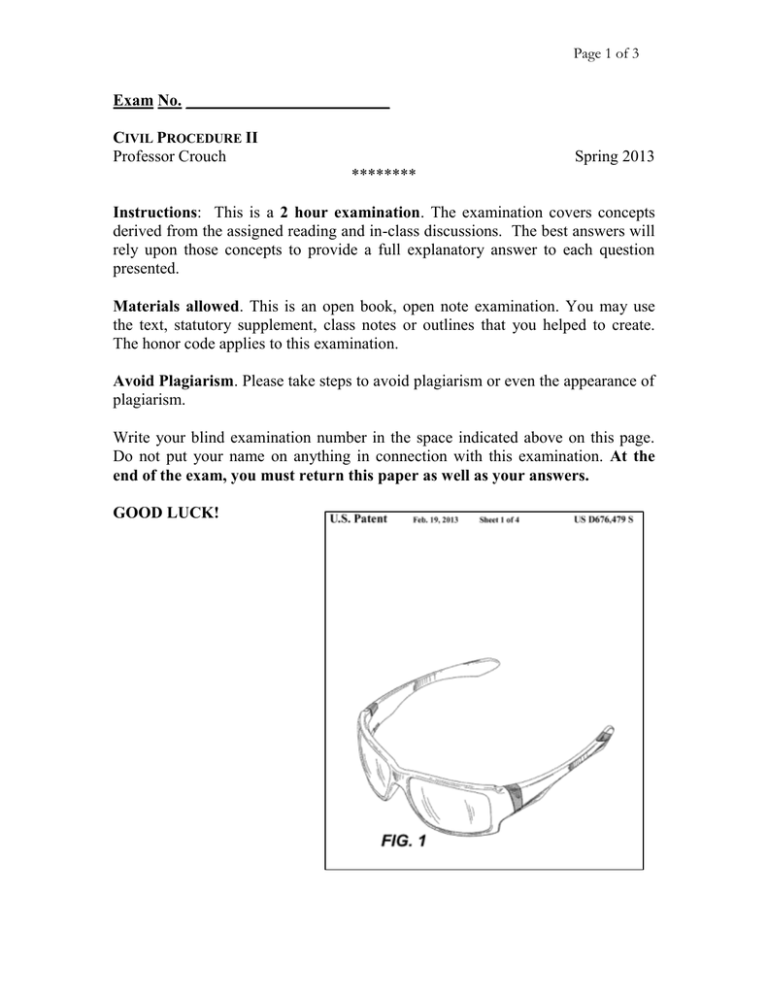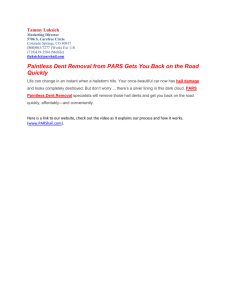Exam No. _________________________ C P
advertisement

Page 1 of 3 Exam No. _________________________ CIVIL PROCEDURE II Professor Crouch Spring 2013 ******** Instructions: This is a 2 hour examination. The examination covers concepts derived from the assigned reading and in-class discussions. The best answers will rely upon those concepts to provide a full explanatory answer to each question presented. Materials allowed. This is an open book, open note examination. You may use the text, statutory supplement, class notes or outlines that you helped to create. The honor code applies to this examination. Avoid Plagiarism. Please take steps to avoid plagiarism or even the appearance of plagiarism. Write your blind examination number in the space indicated above on this page. Do not put your name on anything in connection with this examination. At the end of the exam, you must return this paper as well as your answers. GOOD LUCK! Spring 2013 Civil Procedure II Page 2 of 3 Question: Dent holds a patent covering a popular designs of sunglasses. It turns out that sunglasses are easy to counterfeit. Dent is always on the lookout for knockoffs and recently found unauthorized versions being sold by various individuals including Baker, Campbell, Haseltine, and Vincent. Dent sued Baker in the United States District Court for the Eastern District of Missouri alleging patent infringement. After receiving the complaint, Baker had his production manager (Morgan) review the product sales history. Morgan delivered an internal memorandum to Baker indicating that Baker sold 10,000 allegedly infringing sunglasses in the past year for a total revenue of $85,000. The report was marked "Confidential." a) What information regarding the sales must Baker include in his initial disclosures under Rule 26(a)? (5 points) b) Under what circumstances would a Court Order Baker to turn over the report to Dent? (10 points) c) Assuming that the court has issued what Baker believes is an erroneous order forcing Baker to turn-over the report to Dent. Can Baker appeal that order? (5 points) ==== After trial, a jury returns a verdict for Dent and against Baker (finding infringement). Dent then sues Campbell in the same court also alleging patent infringement. d) Can Dent assert either claim preclusion or issue preclusion in the case against Campbell? (10 points) ==== In the patent case against Campbell, patent infringement must be proven by a preponderance of the evidence. During discovery, Dent's expert provides testimony that Campbell's products infringe the patent while Campbell does not provide any competing evidence of non-infringement. Dent then moves for summary judgment of infringement. In response, Campbell only argues that a jury will find the expert testimony untrustworthy. e) Should the court order summary judgment? (15 points) ==== Spring 2013 Civil Procedure II Page 3 of 3 The United States later brings a criminal prosecution against Baker for criminal counterfeit in United States District Court for the Western District of Missouri. f) Can the US Government assert either claim preclusion or issue preclusion in the case against Baker?1 (5 points) ==== Assume that Dent lost the lawsuit against Campbell based on a jury finding that Dent's patent was invalid. Thus, there is one case where the patent was enforced (against Baker) and another where the patent was found invalid (against Campbell). Dent then sued Haseltine in Federal Court in the Eastern District of Texas again alleging infringement of the patent. g) Can Haseltine rely on either claim preclusion or issue preclusion in the case against Dent? (10 points) h) How can we know if the court was correct to send the question of validity to a jury rather than have that question be decided by the judge? (5 points) ==== The patent right is later fully and finally revoked by the US Patent Office. This means that the knock-off versions are actually legal to manufacture and sell in the US. In reaction, Vincent then files a class action lawsuit on behalf of all sellers of knock-off versions of Dent's sunglasses. The complaint alleges unfair competition based upon Dent's assertion of invalid patent rights and demands that the court force Dent to stop all enforcement activity and compensate businesses who suffered under the enforcement strategy. Vincent's information shows that there are more than 1,000 companies that stopped selling knockoffs because of Vincent's enforcement activities even though Baker, Campbell, and Haseltine were the only entities actually sued. i) What are the two most likely sections of Rule 23 that would be used to deny class certification in this case? (15 points) END 1 Assume that criminal counterfeit includes many of the same elements as patent infringement.



